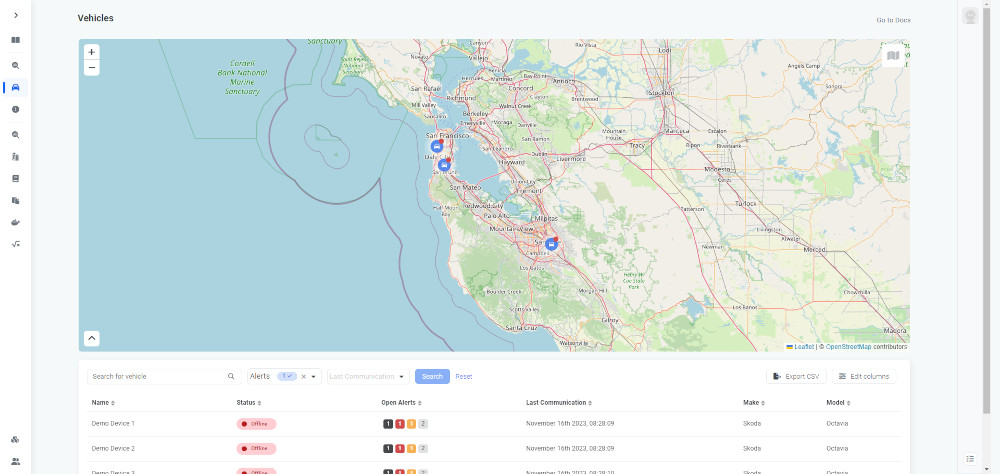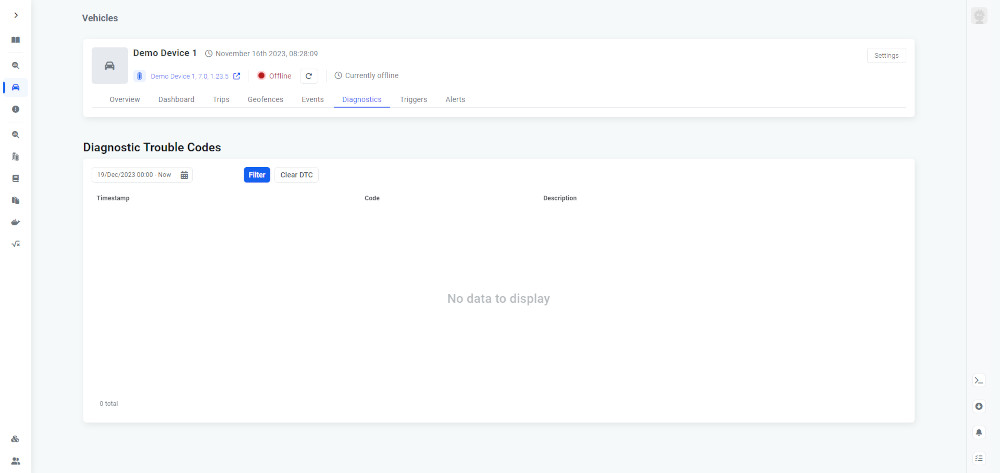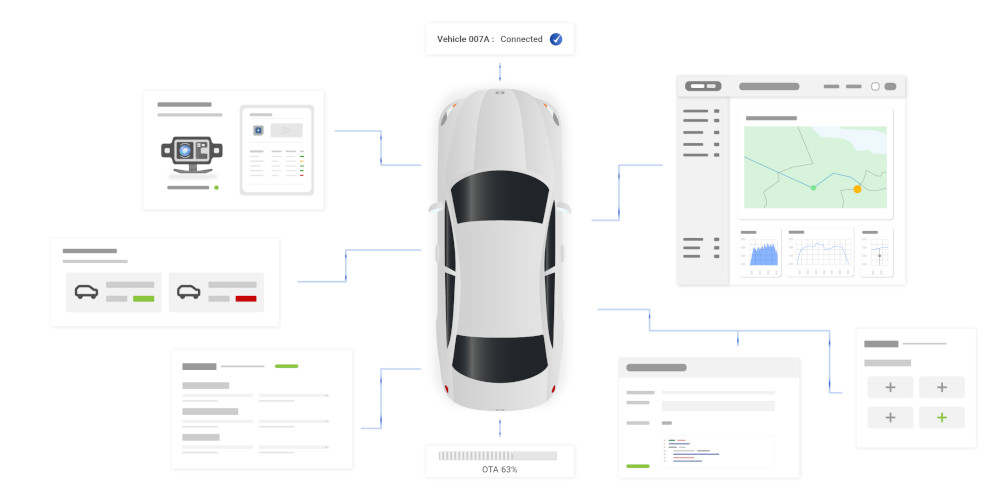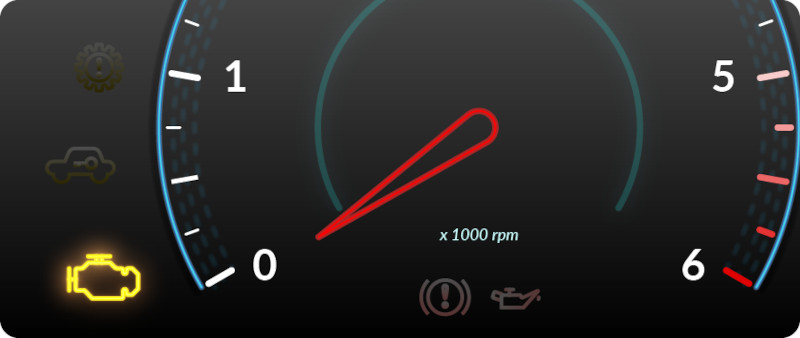Encountering the Check Engine Light on your dashboard can be daunting, but with AutoPi, it doesn't have to be.
This guide introduces the AutoPi CAN-FD Pro device and the AutoPi Cloud platform, your key tools in diagnosing and addressing vehicle issues signaled by the Check Engine Light.
Learn how to effortlessly read and reset fault codes, turning a moment of concern into an opportunity for vehicle optimization. Whether for a single car or an entire fleet, AutoPi simplifies vehicle maintenance and puts control back in your hands.

What is the Check Engine Light?
The Check Engine Light, often symbolized by an engine-shaped icon on your dashboard, is a critical alert from your vehicle's onboard diagnostics system. It's designed to warn you of various issues, ranging from simple fixes to more complex mechanical problems.
-
Loose Fuel Cap: A cap that's not tightened properly can trigger the light due to fuel vapor leakage.
-
Spark Plug Issues: Worn or malfunctioning spark plugs can cause engine misfires, prompting the light.
Minor Causes for Check Engine Light Activation:
-
Oxygen Sensor Failure: A faulty oxygen sensor can lead to incorrect fuel mixture readings, affecting engine performance and emissions.
-
Catalytic Converter Problems: This vital component reduces exhaust gases. If it fails, it could lead to significant engine performance issues.
-
Mass Airflow Sensor Malfunction: This sensor measures the amount of air entering the engine. A malfunction can disturb the engine's air-fuel balance, affecting its efficiency.
Major Concerns Indicated by the Check Engine Light:
Understanding the reason behind the Check Engine Light Codes is essential in determining the right course of action.
While some issues might be simple enough to handle yourself, others require professional intervention. The AutoPi CAN-FD Pro device simplifies this diagnostic process, helping you pinpoint the cause swiftly and accurately.
In the next section, we'll explore how the AutoPi device assists in reading and interpreting these fault codes.
Common Diagnostic Trouble Codes (DTCs)
The chart below lists frequently encountered OBD-II fault codes, their plain-language descriptions, probable root causes, and the first fix to attempt. Keep it on-hand when scanning with an AutoPi device so you can move from code to corrective action without wading through bulky service manuals.
| DTC Code | Description | Likely Cause | Suggested Fix |
|---|---|---|---|
| P0171 | System Too Lean (Bank 1) | Vacuum leak or MAF sensor drift | Inspect hoses, clean/replace MAF |
| P0300 | Random/Multiple Misfire | Spark plugs, coils, clogged injector | Replace plugs, swap coils, injector clean |
| P0420 | Catalyst Efficiency Below Threshold | Aged catalytic converter or O₂ sensor | Check O₂ sensor, test converter |
| P0128 | Coolant Temp Below Regulating Range | Stuck-open thermostat | Replace thermostat |
| P0401 | EGR Flow Insufficient | Carbon-clogged EGR passages | Clean/replace EGR valve |
| P0455 | EVAP System Large Leak | Loose/faulty fuel cap or hose crack | Tighten cap, smoke-test hoses |
Reading Fault Codes With AutoPi
Diagnosing car issues becomes significantly easier with the AutoPi CAN-FD Pro devices.
This innovative tool is designed to accurately log all diagnostic trouble codes (DTCs) that your car generates. But it doesn't stop there; AutoPi goes beyond mere logging.
-
Detailed Error Logging: Each time your car experiences an issue, the AutoPi device records the specific error code, along with the time and GPS location. This feature is invaluable in pinpointing exactly when and where a problem occurred, helping you understand the context of each issue.
-
Real-Time Alerts: If a fault code is detected during your journey, the AutoPi system immediately informs you through the dashboard. This instant notification allows for a swift assessment of the situation, enabling you to take appropriate action without delay.
-
Comprehensive Error Descriptions: One of the standout aspects of the AutoPi system is its ability to provide detailed explanations of each error code, including its severity and potential solutions. This clarity transforms complex car diagnostics into understandable insights, even for those without technical automotive knowledge.
Key Features of AutoPi for Fault Code Diagnosis:

These features ensure that you're not just aware of the problems but also equipped with the knowledge to address them.
In the next section, we'll look into how you can use the AutoPi Cloud to interpret and act on this data.
Interpreting Data on AutoPi Cloud
With fault codes accurately logged by the AutoPi device, the AutoPi Cloud becomes your gateway to insightful vehicle data. This cloud-based platform transforms raw diagnostics into meaningful information, essential for optimal vehicle maintenance and performance.
-
User-Friendly Interface: Navigating through the AutoPi Cloud is a breeze, thanks to its intuitive design. It provides a straightforward view of your vehicle’s diagnostics, making it accessible even for those new to car tech.
-
Data Visualization: The AutoPi Cloud excels in turning complex diagnostic data into clear, visual formats. It displays the history of fault codes, complete with timestamps and GPS locations, offering you a comprehensive overview of your vehicle’s health over time.
-
Insightful Data Analysis: More than just a diagnostic tool, the AutoPi Cloud provides in-depth analysis of your vehicle's data. This information is invaluable for proactive vehicle management, ensuring you're always a step ahead in maintaining your vehicle's health.
Leveraging the Power of AutoPi Cloud for Insightful Vehicle Data:

Armed with this detailed, insightful data from the AutoPi Cloud, you're equipped to make informed decisions about your vehicle's maintenance and care.
In the next section, we'll look into how to reset fault codes using the AutoPi Cloud and the precautions to consider.
Resetting Fault Codes with AutoPi Cloud
Addressing and resetting fault codes is a crucial aspect of vehicle maintenance, and the AutoPi Cloud simplifies this process significantly.
Resetting diagnostic codes can be useful, but it is important to understand the correct conditions and procedures to ensure safe and accurate results.
-
Easy Reset Process: If you've addressed the issue causing the fault code, resetting it is straightforward with the AutoPi Cloud. The platform allows you to clear fault codes directly, ensuring that your vehicle's diagnostic system is up to date.
-
Maintaining a Record: Even after resetting, the AutoPi Cloud keeps a record of the cleared codes. This historical data is valuable for tracking recurring issues or providing information to your mechanic for more complex problems.
-
Cautionary Measures: It's essential to remember that resetting a fault code does not necessarily fix the underlying issue. It's a step in the process, not the solution itself. Always investigate the cause of a warning light or engine light thoroughly. If in doubt, professional advice from a mechanic should be sought.
How to Reset Fault Codes Using AutoPi:
-
Complex Issues: For more complicated problems, such as those related to the catalytic converter or the transmission, professional diagnosis and repair are recommended.
-
Recurring Faults: If a particular fault code keeps reappearing, it may indicate a deeper, unresolved issue that requires expert attention.
When to Seek Professional Help:

By using the AutoPi Cloud, you gain not only the ability to reset fault codes but also the knowledge to do it wisely. This ensures that your vehicle remains in top condition, avoiding unnecessary complications down the road.
Benchmark Results
To validate the real-world impact of an integrated AutoPi solution, we instrumented 25 delivery vans for two weeks, half fitted with a generic Bluetooth OBD-II dongle and phone app, the other half using an AutoPi TMU CM4 streaming data to AutoPi Cloud. Each fleet segment logged the time required to detect, upload, and clear diagnostic trouble codes (DTCs) as well as the success rate on the first repair attempt. The averages below demonstrate where embedded LTE, dual-CAN logging, and cloud APIs translate into measurable operational gains.
| Metric | Bluetooth Dongle | AutoPi TMU CM4 | Improvement |
|---|---|---|---|
| Avg. scan-to-code upload (s) | 47 | 9 | -81 % |
| First-attempt fix rate | 68 % | 92 % | +24 pp |
| Time to clear code after repair (s) | 35 | 7 | -80 % |
| Missed DTC uploads | 14 / 250 | 0 / 260 | reliability ✓ |
| Cellular data used (MB / day) | - | 2.1 | Optimised payload |
| Average power draw (W) | - | 4.2 | 12-V tolerant PSU |
Overall, AutoPi detected and cleared faults eight times faster, transmitted every DTC on the first attempt, and boosted first-repair success by 24 percentage points. These gains translate to less roadside downtime, lower diagnostic labour, and faster vehicle turn-round for revenue service.
Maximizing Vehicle Performance with AutoPi
Leveraging the AutoPi platform provides far more value than resolving basic Check Engine Light codes.
It enables a structured and data-driven approach to maintenance and performance optimization. Whether you manage a single vehicle or a full fleet, AutoPi delivers the insights and tools required to maintain consistent and efficient operation.
-
Data-Driven Decision Making: Comprehensive telemetry and cloud analytics provide a clear overview of system status, enabling accurate assessment of maintenance needs.
-
Cost Efficiency: Early detection of issues helps reduce repair expenses. AutoPi identifies deviations and fault patterns before they develop into major failures.
-
Improved Vehicle Lifespan: Consistent monitoring and scheduled maintenance supported by AutoPi contributes to long-term reliability and performance stability.
Advantages of Using AutoPi for Vehicle Maintenance:

Ready to Optimize Your Vehicle Performance?
If you're interested in learning more about how AutoPi can revolutionize your approach to vehicle maintenance, or if you have specific queries about its features, don't hesitate to contact us. Our team is dedicated to helping you make the most out of your vehicle, ensuring peak performance and safety on the road.
Feel free to reach out, and let's drive towards a smarter, more connected automotive experience with AutoPi.
FAQs about Check Engine Light
Resetting the check engine light (CEL) can be done in several ways:
- Using an OBD2 Scanner:
- Plug the scanner into the OBD2 port.
- Switch ignition to “On” without starting the engine.
- Select “Read Codes” on the scanner and review errors.
- Choose “Clear Codes” or “Reset” after repairs or diagnostics.
- Battery-disconnect method:
- Turn off the vehicle and loosen the negative battery terminal.
- Wait 15–20 minutes, reconnect, and retest. The CEL may return if the root issue persists.
- Address the issue:
- Fixing the root cause (e.g., replacing a faulty gas cap) often clears the light after several drive cycles.
- Visit a mechanic for persistent or severe faults.
Note: Always diagnose the underlying fault before clearing the CEL to avoid long-term damage.
The CEL appears as an engine symbol or “Check Engine” text. It signals the ECU has detected a fault in the engine or emissions system.

A steady CEL often indicates minor issues such as a loose gas cap, while a flashing CEL warns of severe misfire that can damage the catalytic converter. Scan for codes immediately to determine severity.
Check the gas cap, reduce speed, and use a scanner to read codes. If flashing, limit driving and seek immediate professional diagnostics.
Use an OBD-II scanner or, on some vehicles, disconnect the battery. Always confirm the underlying fault is fixed before clearing the light.
Some cars allow battery disconnect resets, but results vary. Use a scanner for a reliable clear and always fix the root issue first.
Remember that while these answers provide general guidance, always consult your vehicle's owner manual or a mechanic for specific advice.





